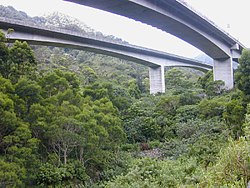Interstate H-3: Difference between revisions
No edit summary |
|||
| Line 13: | Line 13: | ||
}} |
}} |
||
[[Image:H3_viaduct_Halawa.jpg|thumb|right|250px|Interstate H-3 in Halawa Valley looking towards the [[Koolau Range|Ko'olau crest]]]] |
[[Image:H3_viaduct_Halawa.jpg|thumb|right|250px|Interstate H-3 in Halawa Valley looking towards the [[Koolau Range|Ko'olau crest]]]] |
||
'''Interstate H-3''' (abbreviated '''H-3''' or '''I-H-3''') is an intrastate [[interstate highway]] located on the island of [[Oahu|O‘ahu]] in the state of [[Hawaii| |
'''Interstate H-3''' (abbreviated '''H-3''' or '''I-H-3''') is an intrastate [[interstate highway]] located on the island of [[Oahu|O‘ahu]] in the state of [[Hawaii|Hawai‘i]], [[United States]]. H-3 is also known as the '''John A. Burns Freeway'''. Despite the number, signage is that of an east-west highway. However, most residents would consider the route to run north and south: from the windward (northeast) coast to the south side of the island. Its western (or southern) terminus is at an intersection with [[Interstate H-1]] at Hālawa near [[Pearl Harbor]]. Its eastern end is at the main gate for [[Marine Corps Base Hawaii]] (MCBH). This route satisfies the national defense purpose of connecting the Marine Corps base with the U.S. Navy port at Pearl Harbor off Interstate H-1. |
||
==Length== |
==Length== |
||
Revision as of 17:38, 25 May 2006

Interstate H-3 (abbreviated H-3 or I-H-3) is an intrastate interstate highway located on the island of O‘ahu in the state of Hawai‘i, United States. H-3 is also known as the John A. Burns Freeway. Despite the number, signage is that of an east-west highway. However, most residents would consider the route to run north and south: from the windward (northeast) coast to the south side of the island. Its western (or southern) terminus is at an intersection with Interstate H-1 at Hālawa near Pearl Harbor. Its eastern end is at the main gate for Marine Corps Base Hawaii (MCBH). This route satisfies the national defense purpose of connecting the Marine Corps base with the U.S. Navy port at Pearl Harbor off Interstate H-1.
Length
| Miles | km | ||
| 16 | 26 | Hawaii | |
| 16 | 26 | Total | |
Major cities
Bolded cities are officially-designated control cities for signs.
Intersections with other interstates
- Interstate H-1 at Hālawa
- Interstate H-201 or SR 78 at Hālawa
Spur routes
None
Notes

This road is an engineering wonder, and perhaps the most expensive (on a cost per unit distance basis) of any Interstate constructed. It crosses the Ko'olau mountain along a viaduct and through the 5,165 foot (1.6 km) long Tetsuo Harano Tunnels. For over 20 years, the completion of this highway was uncertain, as it runs through culturally and environmentally sensitive areas and some park lands were eventually used. But now, this is a beautiful freeway running through a subtropical forest and over the rugged spine of windward O'ahu.
This roadway is somewhat unique in another respect. It is the only significant span of roadway on O‘ahu and perhaps in Hawai‘i where drivers regularly travel at speeds over 60 mph (100 km/h), and 70 mph (110 km/h) is typical. The posted speed limit varies between 45 and 60 mph (70-100 km/h).
An interesting story relates to the elevated section passing through Ha‘ikū Valley (see photograph of viaducts in Ha‘ikū Valley below). In this valley (the most scenic section of H-3) the viaduct passed beneath the antenna of a U.S. Coast Guard radio transmission facility. It was thought that the energy field from the antenna could interfere with heart pacemakers—a potential detriment to drivers and passengers on the roadway. A giant metal cage was designed to surround the roadway through the valley. Before H-3 was opened, the Coast Guard closed their transmitting facility, obviating the need for the cage. Although the full cage was never built, buried within the roadway was the bottom of the cage. HDOT decided to remove this steel mesh (at considerable expense) prior to opening of the freeway to minimize inconvenience to the motoring public at some later time.
The highway was featured in a Honda commercial in the early 2000s. In the ad, two men drive along H-3 in a Civic, and one of them questions the existence of Interstate highways in Hawaii.

Template:Hawaii State Highways
